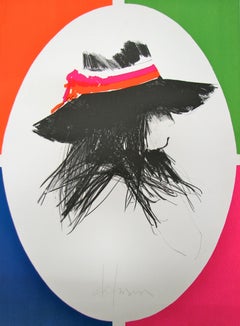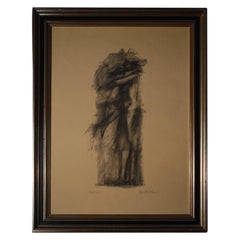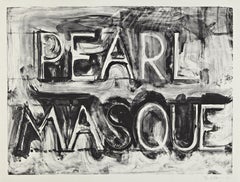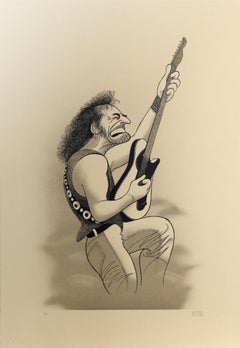Lithograph By Bruce
1970s Modern Figurative Prints
Lithograph
Late 20th Century Minimalist Abstract Prints
Lithograph
1980s Abstract Abstract Prints
Lithograph
1970s Modern More Prints
Lithograph
1960s Post-Modern Portrait Prints
Lithograph
1960s Prints and Multiples
Lithograph
Vintage 1970s American Minimalist Contemporary Art
Paper
Recent Sales
1980s Minimalist Prints and Multiples
Lithograph
1990s Post-Modern Portrait Prints
Lithograph
1990s Post-Modern Figurative Prints
Lithograph
Vintage 1980s American Minimalist Contemporary Art
Paint, Paper
1840s Landscape Prints
Lithograph
1980s More Prints
Lithograph
1840s Landscape Prints
Lithograph
1840s Landscape Prints
Lithograph
People Also Browsed
1980s Minimalist Abstract Prints
Lithograph
21st Century and Contemporary Swedish Mid-Century Modern Table Lamps
Textile
1970s Abstract Geometric Abstract Prints
Screen
21st Century and Contemporary Mexican Mid-Century Modern Floor Lamps
Textile, Wood, Linen, Fiberglass
2010s American Organic Modern Side Tables
Travertine
1960s Abstract Geometric Abstract Prints
Screen
2010s Mexican Brutalist Lounge Chairs
Hardwood
1970s Pop Art Landscape Prints
Board, Screen
Vintage 1970s Danish Mid-Century Modern Beds and Bed Frames
Teak
1980s Minimalist Abstract Prints
Lithograph
2010s French International Style Daybeds
Fabric, Oak
Vintage 1970s French Mid-Century Modern Table Mirrors
Gold Plate
1990s Contemporary Abstract Prints
Etching
Vintage 1960s Italian Mid-Century Modern Table Lamps
Steel
Vintage 1970s American Mid-Century Modern Figurative Sculptures
Stone
1990s Abstract Expressionist Abstract Prints
Handmade Paper, Color, Lithograph
Lithograph By Bruce For Sale on 1stDibs
How Much is a Lithograph By Bruce?
Finding the Right Prints-works-on-paper for You
Decorating with fine art prints — whether they’re figurative prints, abstract prints or another variety — has always been a practical way of bringing a space to life as well as bringing works by an artist you love into your home.
Pursued in the 1960s and ’70s, largely by Pop artists drawn to its associations with mass production, advertising, packaging and seriality, as well as those challenging the primacy of the Abstract Expressionist brushstroke, printmaking was embraced in the 1980s by painters and conceptual artists ranging from David Salle and Elizabeth Murray to Adrian Piper and Sherrie Levine.
Printmaking is the transfer of an image from one surface to another. An artist takes a material like stone, metal, wood or wax, carves, incises, draws or otherwise marks it with an image, inks or paints it and then transfers the image to a piece of paper or other material.
Fine art prints are frequently confused with their more commercial counterparts. After all, our closest connection to the printed image is through mass-produced newspapers, magazines and books, and many people don’t realize that even though prints are editions, they start with an original image created by an artist with the intent of reproducing it in a small batch. Fine art prints are created in strictly limited editions — 20 or 30 or maybe 50 — and are always based on an image created specifically to be made into an edition.
Many people think of revered Dutch artist Rembrandt as a painter but may not know that he was a printmaker as well. His prints have been preserved in time along with the work of other celebrated printmakers such as Pablo Picasso, Salvador Dalí and Andy Warhol. These fine art prints are still highly sought after by collectors.
“It’s another tool in the artist’s toolbox, just like painting or sculpture or anything else that an artist uses in the service of mark making or expressing him- or herself,” says International Fine Print Dealers Association (IFPDA) vice president Betsy Senior, of New York’s Betsy Senior Fine Art, Inc.
Because artist’s editions tend to be more affordable and available than his or her unique works, they’re more accessible and can be a great opportunity to bring a variety of colors, textures and shapes into a space.
For tight corners, select small fine art prints as opposed to the oversized bold piece you’ll hang as a focal point in the dining area. But be careful not to choose something that is too big for your space. And feel free to lean into it if need be — not every work needs picture-hanging hooks. Leaning a larger fine art print against the wall behind a bookcase can add a stylish installation-type dynamic to your living room. (Read more about how to arrange wall art here.)
Find fine art prints for sale on 1stDibs today.
- What is an after lithograph?2 Answers1stDibs ExpertApril 5, 2022A lithograph is a piece of artwork created using oil and water. An after lithograph is a copy of an existing painting done after the original painting’s creation. Pablo Picasso would have after lithographs created of his famous works, usually by another approved artist. On 1stDibs, find a collection of lithographs from some of the world’s top sellers.1stDibs ExpertApril 5, 2022An “after” lithograph, or after print, refers to a print that is made by an artist based on an original painting or a work by a different artist. For example, a lithographer could make an engraving based on a painting by Picasso, and the resulting print would be “after” Picasso. Shop a collection of after lithography from some of the world’s top art dealers on 1stDibs.
- Why is Bruce Nauman famous?1 Answer1stDibs ExpertJanuary 27, 2025The reason why Bruce Nauman is famous is that he has experimented with many types of media, including ones that had not previously been widely used, to explore complex subjects. For example, Nauman's novel use of neon as a medium has recurred in his works over the decades. He uses neon to make allusions to the numinous connotations of light. Neon also relates to advertising, and in his later works, Nauman has used it ironically with provocative imagery, as seen in his Hanged Man. On 1stDibs, find a range of Bruce Nauman art.
- 1stDibs ExpertNovember 20, 2024The difference between a lithograph and a lithograph print depends on the context. By the strictest definition, the terms are actually synonyms. A lithograph is the term for a print produced through a specific process. It begins with an artist drawing or painting on a stone surface with an oil-based substance, such as a greasy crayon or tusche. The stone is then covered with water, which is repelled by the oily areas. Oil-based ink is then applied to the wet stone, adhering only to the oily image. The stone is then covered with a sheet of paper and run through a press. You can call a print produced with this printmaking method a lithograph, a lithograph print or a lithographic print. However, some people may use the term lithograph to describe a traditional lithograph and lithograph print to denote an offset lithograph. Offset lithography is a method of mass-producing prints where the image from the stone gets transferred to a rubber blanket, which is then pressed against the paper to produce a final image. Find a wide variety of lithographs on 1stDibs.
- 1stDibs ExpertOctober 7, 2024The difference between an offset lithograph and an original lithograph is that the former is made using the other. To produce an original lithograph, a printmaker begins by drawing on or painting on a stone surface with an oil-based substance. The stone is then covered with water, which is repelled by the oily areas. Oil-based ink is then applied to the wet stone, adhering only to the oily image. The stone is then covered with a sheet of paper and run through a press. An offset lithograph is a copy of an original lithograph produced with mechanical processes, usually without the artist's involvement. On 1stDibs, explore a collection of lithographs and other art prints.
- Are Lithographs Valuable?1 Answer1stDibs ExpertFebruary 22, 2021The most valuable lithographs are ones made by the artist, rather than someone mimicking a famous work of art. Original lithographs can be worth tens of thousands of dollars.
- 1stDibs ExpertFebruary 13, 2023Yes, there is a market for lithographs. However, demand for this type of artwork varies based on the artist, subject, age, condition and other factors. Fine art prints are created in strictly limited editions — of 20 or 30 or maybe 50 — and are always based on an image created specifically to be made into an edition. Because an artist’s editions tend to be more affordable and available than his or her unique works, new collectors are often directed toward prints as a starting point. Experts suggest that as collecting prints online has become more common, the market for lithographs and other kinds of prints is poised to flourish in the years to come. On 1stDibs, find a variety of lithographs and other prints from some of the world’s top galleries.
- 1stDibs ExpertJune 6, 2024Lithographs are so expensive largely because of their properties. Compared to other types of prints, they tend to be more painterly, meaning they are better at capturing the qualities of color, stroke and texture featured in an original image. Since they bring paintings and other images to life in rich detail, artists and dealers can sell them for higher prices. Lithographs may also be expensive due to their rarity or creation by a famous artist. Shop a large selection of lithographs on 1stDibs.
- What is a genuine lithograph?1 Answer1stDibs ExpertApril 5, 2022A genuine lithograph is when an artist creates a piece of art on a stone or metal plate that is re-inked every time the image is pressed to paper. To ensure you purchase authentic, high-quality lithographs, look for a reputable seller. Shop a selection of expertly vetted lithograph art on 1stDibs.
- What is a signed lithograph?1 Answer1stDibs ExpertApril 16, 2024A signed lithograph is an art print produced with a particular method that bears the artist's real signature, signed in ink. The term lithograph refers to a print made by drawing an image onto a stone, etching the stone with chemicals and then applying ink. The term signed lithograph is different from a plate-signed lithograph, where the artist adds their signature to the stone to transfer it onto finished prints rather than signing their works by hand. Explore a large collection of lithographs on 1stDibs.
- What is a color lithograph?1 Answer1stDibs ExpertMay 3, 2024A color lithograph is a print produced through the process of chromolithography. Unlike traditional lithography, which uses a single stone and one color of ink, chromolithography involves multiple printing stones, each of which corresponds to a single color. Artists etch the stones with only the elements of the image that will show up in that color, then transfer the image, part by part and color by color, onto paper. Find a range of color lithographs on 1stDibs.
- What is a numbered lithograph?1 AnswerLilac Gallery Ltd.March 17, 2021When a lithograph is numbered by the artist, it means that this particular artwork is from a 'limited edition' series. As when the lithographs are not numbered, they would be from an open edition and the total number similar of artworks is unknown. When a lithograph is numbered it usually also comes hand-signed by the artist.
- What is an original lithograph?1 Answer1stDibs ExpertOctober 19, 2021An original lithograph is a print made by way of a specific printing method (one of the most commonly used methods in the 20th and 21st centuries). With respect to lithography, the process begins by drawing on or painting on a stone surface with an oil-based substance, such as a greasy crayon or tusche (an oily wash). The stone is then covered with water, which is repelled by the oily areas. Oil-based ink is then applied to the wet stone, adhering only to the oily image. The stone is then covered with a sheet of paper and run through a press.
- What is a lithograph poster?1 Answer
 International Fine Arts Consortium - IFAC ArtsMarch 22, 2021It's a print using an offset lithograph press. Although still used today it has been primarily replaced with digital printing.
International Fine Arts Consortium - IFAC ArtsMarch 22, 2021It's a print using an offset lithograph press. Although still used today it has been primarily replaced with digital printing. - Is a lithograph an original?1 Answer1stDibs ExpertApril 16, 2024No, a lithograph is not an original. Lithographs are prints, which are authorized reproductions of works produced by artists. To produce a lithograph, an artist applies an image to a stone. Then, they treat the stone with chemicals to impart the image into it. Finally, they apply ink and transfer the image onto paper or another medium. Shop a large selection of lithographs on 1stDibs.
- Who is a famous lithographer?1 Answer1stDibs ExpertJanuary 27, 2025There are many famous lithographers. One was Alois Senefelder. Sometimes called the “Father of Lithography,” he accidentally discovered the printmaking technique in 1796 when trying to find a new way to make copies of his plays. His discovery eventually led to the use of lithography to produce artwork. During the 18th century, artists who experimented with the technique included Honoré Daumier and Henri de Toulouse-Lautrec.
Lithography became an even more popular art form during the 20th century when it was used by artists like Alphonse Mucha, Marc Chagall, Edvard Munch, Pablo Picasso, Joan Miró, Diego Rivera and Käthe Kollwitz.
Find a wide range of lithographs on 1stDibs. - 1stDibs ExpertSeptember 25, 2019
In a hand-pulled lithograph, the image is painted or drawn by hand on the plate, which is then inked and used to make an impression on the print medium; in an offset lithograph, the inked image is transferred to a rubber blanket or roller, which is then used to mass-produce the prints.
- 1stDibs ExpertAugust 15, 2024To tell the difference between a lithograph and a print, touch the surface of the piece. Lithographs will usually have a slightly raised texture, whereas reproductions of lithographs produced with other techniques are more likely to be smooth. Then, examine the surface closely with a magnifying glass.
On a lithograph, you will typically see irregularities in the dot pattern. Printed reproductions normally don't display such irregularities due to the mechanical processes used to produce them. If you're still uncertain, a certified appraiser or knowledgeable art dealer can help you determine whether a piece is a lithograph or a reproduction print.
On 1stDibs, explore a large selection of lithographs and prints. - Does Banksy make lithographs?1 Answer1stDibs ExpertApril 5, 2022Yes, Banksy makes lithographs. The anonymous English-based artist primarily works in street art and has reproduced his work through stencil work, silkscreens and lithographs. These reproductions are often imitated. Always purchase Banksy prints from a reputable seller to ensure authenticity. Shop a large collection of expertly vetted Banksy prints from some of the world’s top sellers on 1stDibs.
- 1stDibs ExpertAugust 26, 2024The difference between a lithograph and an original is that one is used to produce the other. An original is the term for the stone upon which an artist paints an image using an oil-based substance, such as a greasy crayon or tusche, a type of oily wash. The lithograph is the print that an artist makes with an original. To create a lithograph, oil-based ink is applied to the wet stone, adhering only to the oily image. The stone is then covered with a sheet of paper and run through a press. On 1stDibs, shop a diverse assortment of lithographs.
- 1stDibs ExpertJune 13, 2024The difference between a print and a lithograph is that “print” is a general term and “lithograph” is a specific printing method (one of the most commonly used in the 20th and 21st centuries). This means that a lithograph is always a print, but not all prints are lithographs. A print is a work of art made by imprinting a design from a matrix made of one of the following media: stone, wood or metal. The artist creates the design on the matrix which is then inked and transferred onto the support. The support is usually made of paper. With respect to lithography, the process begins by drawing on or painting on a stone surface with an oil-based substance, such as a greasy crayon or tusche (an oily wash). The stone is then covered with water, which is repelled by the oily areas. Oil-based ink is then applied to the wet stone, adhering only to the oily image. The stone is then covered with a sheet of paper and run through a press.
Find lithographs and other types of art prints for sale on 1stDibs.
Read More
Revisiting Robert Rauschenberg’s Creative Rebellion on His 100th Birthday
A planet-wide celebration feels fitting for an artist who saw connections everywhere: between paint and photography, art and life, self and surroundings.
Red Grooms’s 3D Tugboat Is a Chaotic, Comic Take on New York Life
The sculptural lithograph is part of the inimitable artist’s “Ruckus” series, now on view at the Brooklyn Museum.
Joan Mitchell’s Rare, Late-Career Diptych Buzzes with Life
Beneath the inky blackness, the painter’s irrepressible energy electrifies this pair of intaglio prints.
The 1stDibs Guide to Types of Abstract Art
Get to know the key movements and artists who have influenced visual culture for more than a century.
Romare Bearden’s Humanity Infuses His Bright, Bold Art
Through collage, painting and printmaking, the artist foregrounded Black life in America in revolutionary new ways.
Andy Warhol and Suzie Frankfurt’s ‘Wild Raspberries’ Cookbook Is an Artful, Fanciful Delight
This set of recipes and original prints might not make you a better chef. But it will make you smile.
Art Brings the Drama in These Intriguing 1stDibs 50 Spaces
The world’s top designers explain how they display art to elicit the natural (and supernatural) energy of home interiors.
Welcome (Back) to the Wild, Wonderful World of Walasse Ting
Americans are rediscovering the globe-trotting painter and poet, who was connected to all sorts of art movements across a long and varied career.





